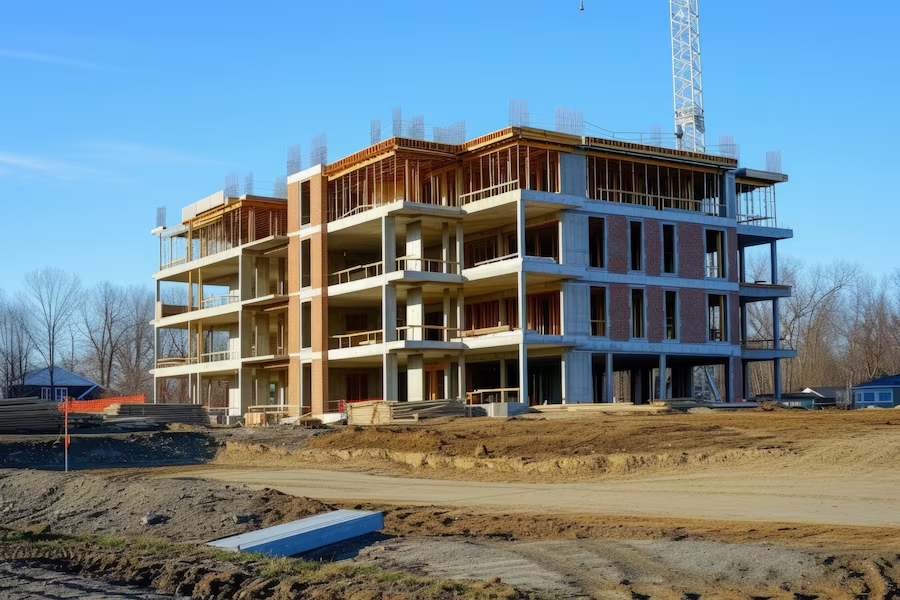
Have you been amazed by towering skyscrapers, sleek modern buildings, cantilevered structures, or impressive cable-stayed bridges that seem to defy gravity and withstand any storm? The credit goes to civil and structural engineers—the professionals who turn ambitious architectural visions into reality, ensuring that these structures stand strong and safe, even in the face of natural disasters. From design to problem-solving, they are essential in ensuring that our buildings are not only visually striking but also reliable, safe, and fully compliant with all regulatory standards.
If you're thinking about pursuing this exciting and impactful profession, you're in the right place! This article will explore what structural engineers do, how to become one, and the technical and soft skills needed to succeed in this field. You’ll also learn about the average structural engineer salaries and the best educational resources and training programmes to help you embark on a successful career.
Understanding the Role of a Structural Engineer

A structural engineer is responsible for figuring out how buildings and other structures remain upright and strong. They take architectural concepts and ensure they are safe and stable by running calculations and testing designs. Essentially, they transform creative ideas into real, reliable structures that can withstand anything nature throws at them. Below is an overview of the roles and responsibilities that civil and structural engineers hold in the infrastructure sector:
1. Designing Structures
Once architects provide the initial design drawings, civil and structural engineers create detailed 2D drawings that outline the framework and structural details. They ensure the design's integrity by accounting for the loads and forces the structure will face. These detailed drawings are essential for the construction team to start the project. It is the structural engineer's responsibility to produce clear, readable, and easily understandable drawings for the construction workers on the ground.
2. Assessing Load Bearing
The analysis conducted by structural engineers is crucial to a project's success. They perform precise calculations using specialised software to determine how a structure will respond to natural forces like wind, gravity, and various loads. These evaluations are key to creating a design that ensures safety and stability once the project is completed. Civil and structural engineers assess live loads, such as the weight of moving crowds and objects within the space, and dead loads, which refer to the static weight of the building itself, including columns, beams, slabs, and other structural elements.
3. Ensuring Safety and Adherence to Regulations
Civil and structural engineers are responsible for the safety of both the building and its future occupants, ensuring compliance with local government norms and regulations. These standards are in place to ensure infrastructure meets rigorous safety benchmarks. Adhering to these guidelines is essential for creating functional spaces that meet regulatory safety requirements. Without following these standards, structural engineers cannot obtain the necessary certifications from governing bodies to put the structure into use.
4. Collaborating with Allied Professionals
Civil and structural engineers must maintain ongoing communication with architects, contractors, and MEP engineers to ensure the design is executed effectively. From project initiation to completion, professionals in the AEC industry must work closely together. Structural engineers collaborate with architects to confirm that design decisions are feasible on-site and address any factors the architect might overlook. They also communicate with the construction team to ensure seamless and accurate project execution.
5. Addressing Issues and Finding Solutions
Structural engineers must be prepared to handle unexpected issues on-site, such as challenging conditions or last-minute design changes. They play a key role in keeping the project on track and ensuring it stays on schedule without compromising quality and safety. Their quick thinking and problem-solving skills are crucial for developing solutions on the spot. To enhance these abilities, structural engineers often stay updated on industry news and case studies, learning from past experiences to tackle new challenges effectively.
6. Ensuring Long-Term Durability
Civil and structural engineers are the experts who ensure that a project stands the test of time. By keeping the building strong and trouble-free, they help clients save money in the long run and contribute to the environment by reducing the need for repairs and new materials. They also stay informed about the latest materials and their pros and cons, enabling them to advise clients on the best choices for their projects.
Structural Engineer Job Description
To become a structural engineer, you generally need a Bachelor's degree in Engineering, with many professionals pursuing a Master’s in Structural Engineering for more advanced knowledge. Specialising in areas like seismic design, bridge engineering, or skyscraper construction is not required, but it can set you apart and help you carve out a niche in the field. In addition to formal education, strong problem-solving skills, project management abilities, and proficiency in design and coordination with other professionals are crucial. A thorough understanding of industry standards, materials, and techniques, along with a solid foundation in analysis and calculations, is also essential for success in structural engineering services.
1. Essential Skills & Qualifications
Educational Background
A degree in civil engineering with a specialisation in structural engineering is fundamental for a career in this field. However, to remain competitive and effective, engineers must continuously update their knowledge and skills, particularly in industry-standard software. Certification programmes are available to help engineers stay ahead in the AEC industry. These courses, typically lasting between 3 to 6 months, provide training in the latest software and technologies, ensuring a seamless workflow and keeping professionals at the forefront of the field.
Technical Skills

-
Software Skills
For graduates and aspiring engineers, mastering tools such as Revit, STAAD.Pro, ETABS, SAFE, Tekla Structure, SAP2000, ZWCAD, BricsCAD, Strand7, and MicroStation has become crucial for career success. The industry has embraced technological advancements to streamline workflows, cut costs, save time, reduce errors, and ensure projects are completed on schedule. Developing expertise in these software tools is essential for staying competitive and effective in the evolving field of structural engineering. -
Construction Techniques
Understanding the different methods and practices used to build and assemble structures and figuring out which ones are right for each project is important. It also involves handling materials properly—choosing the right ones and using them correctly. Engineers need to plan out the construction sequence to keep things on track and minimise delays, and they also have to check that everything meets quality standards. -
Documentation
It involves producing high-quality drawings that are clear and understandable to everyone involved. Documentation also includes writing detailed reports on construction stages, recording the workflow, and noting any discrepancies or issues that arise on-site. This comprehensive documentation ensures that the entire team is informed about the project's progress and any challenges encountered, facilitating effective communication and coordination. -
Risk Assessment
Risk assessment involves identifying, evaluating, and managing potential problems that could affect a project's safety, stability, and success. This includes examining site issues such as soil quality and environmental factors, as well as assessing how design choices will perform. Engineers need to analyse how various loads and potential failure points might impact the structure. They must also make design adjustments and implement safety measures to address these issues. -
Project Management
Project management is about planning, executing, and monitoring projects to ensure they are completed on time, within budget, and meet all quality standards. This includes developing a detailed plan, scheduling tasks, and managing resources such as the budget and materials. It also involves coordinating the team, collaborating with all stakeholders, overseeing inspections and testing, and keeping clients informed. Additionally, it requires tracking progress and handling all reporting to ensure the project runs smoothly.
Soft Skills

-
Ability to Collaborate
Structural engineers need to work closely with architects, contractors, and MEP engineers to ensure the success of a project. This involves assisting and supporting fellow professionals whenever their expertise is needed. -
Proficiency in Communication
It’s crucial to clearly convey technical details to stakeholders, clients, and ground workers in a way that's easy to understand. Engineers must actively communicate with everyone involved in the project to grasp its needs and ensure all parties are on the same page. -
Ability to Lead
Engineers should be able to guide and lead their team effectively, making informed design decisions that keep the project on track and drive better outcomes. -
Capacity to Negotiate
Being able to mediate between clients, contractors, and other stakeholders is essential. Engineers need to find common ground or solutions to disputes that satisfy all parties involved. -
Taking Responsibility
Taking ownership of delivering high-quality work and being accountable if issues arise during construction or design is key. Engineers must adhere to ethical standards and maintain professionalism throughout their careers.
Career Path & Progression for Structural Engineer

1. Entry-level roles
Entry-level roles typically include positions such as junior or entry-level structural engineer, assistant structural engineer, and site engineer. As newcomers to the field, their responsibilities often involve assisting with design, performing calculations, drafting plans, and conducting site inspections. Those in these roles are also in the process of acquiring practical skills not covered in their coursework, such as using specialised software and other essential industry tools.
- Salary: INR 2.5 - 5 lakhs per annum approximately (Junior and assistant structural engineer)
- Salary: INR 3 - 6 lakhs per annum approximately (Site engineer)
2. Mid-level Roles
At the mid-level, roles such as civil and structural engineer, project engineer, or design engineer are common, typically for professionals with 3 to 6 years of experience. Engineers at this level manage projects, lead small teams, collaborate with other professionals, and deliver detailed design work. They are also responsible for ensuring that all work complies with regional codes and regulations, conducting thorough checks to maintain adherence to safety and quality standards.
- Salary: INR 6 - 12 lakhs per annum approximately
Also Read - How To Become A BIM Technician : Get Insights On Salary & Skills Needed
3. Senior-level Roles
Roles such as senior structural engineer, principal engineer, or project manager fall into this category and typically require more than 6 years of experience. At this senior level, professionals manage large teams, oversee major projects, and serve as the primary point of contact with clients regarding project updates and changes. They are also the key decision-makers for critical design issues, leveraging their extensive experience to solve complex problems and ensure project success.
- Salary: INR 12 - 20 lakhs per annum approximately
4. Advanced Roles
Advanced roles in structural engineering services include engineering manager, director of engineering, or chief structural engineer. With over 10-12 years of experience, these professionals lead their departments and manage multiple projects and teams. They play a key role in strategic decision-making, business development, and driving company initiatives, using their extensive expertise to shape the direction and growth of the organisation.
- Salary: INR 18 - 30 lakhs per annum approximately
Also Read - Check 20 Best Structural Engineering Companies To Work In (India & USA)
Top 5 Certifications & Courses for Structural Engineers

Certification courses are essential for civil and structural engineers as they ensure their skills remain current with the latest tools and techniques. These courses help engineers stay abreast of industry standards, deepen their expertise in specialised areas, and improve their job prospects. They also offer practical insights that can be applied directly to real-world projects, helping engineers stay competitive and perform at their best. Here are five certification courses that engineers might consider:
1. BIM Professional Course for Civil Engineers by Novatr
Duration: 7 months
Fee: INR 1,95,000
Mode of study: Online
Novatr’s BIM Professional Course for Civil Engineers is an exceptional programme for a structural engineering job. This course offers a comprehensive curriculum, guiding participants through the fundamental concepts of information modelling, parametric structure families, documentation, and presentation. It also delves into advanced topics like 3D visualisation, BIM for infrastructure, and 4D and 5D modelling. The course places a strong emphasis on practical skills, addressing key aspects such as cloud collaboration, streamlined workflows, coordination, and clash detection. What sets it apart is the guidance provided by industry experts throughout the learning period. By the end of the course, participants are encouraged to apply their understanding through a real-world RIBA-structured capstone project. It is an ideal course for construction managers looking to upskill themselves.
2. The Engineering of Structures Around Us Specialisation by Coursera
Duration: 2 months
Fee: INR 6,000
Mode of study: Online
This short course offers a comprehensive introduction to the fundamentals of engineering, divided into five segments covering different topics. Learners can progress through these segments at their own pace. The course explores how various forms handle compression and tension, their response to loads, and the reasoning behind selecting specific construction systems. It aims to help learners build prototypes and conceptual designs, understand the nature of loads on structures, and compare different systems for handling those loads. Upon completing the course, learners receive a certificate from Coursera, and the course is taught by Dartmouth College.
3. BIM-ready Civil Course by TechnoStruct Academy
Duration: 6 months
Fee: INR 1,25,000
Mode of Study: Online
This in-depth course from TechnoStruct Academy enhances structural engineers' visibility in the professional field. It covers not only Revit but also additional software like Tekla, Civil 3D, and Advanced Steel, providing students with a well-rounded skill set. The course emphasises BIM for its role in designing and analysing structures to anticipate potential risks. Additionally, it includes an internship opportunity, offering practical experience and real-world exposure to complement the learning.
4. Revit for Structural Engineers by edX
Duration: 5 weeks
Fee: INR 20,909
Mode of Study: Online
This beginner-friendly course from edX is perfect for structural engineers looking to understand virtual design and the basics of BIM and its industry workflow. It offers detailed instruction on Revit components, 3D modelling, and the construction of steel and concrete structures. Partnering with the University of Maryland, edX provides a programme designed to enhance career prospects. The self-paced format is ideal for busy professionals who cannot commit to a strict schedule, and lifetime access ensures you can revisit the material whenever needed.
5. Master Study in Structural Engineering by E-construct Design & Build Pvt. Ltd.
Duration: 12 months
Fee: INR 2,10,000
Mode of study: Online and Offline
This year-long intensive programme is designed to provide professionals with hands-on experience that enhances job prospects upon completion. Participants will work on live projects involving high-rise structures, such as G+40 to G+50 storey buildings, using industry-standard software like STAAD.Pro, ETABS, SAFE, RCDC, and SAP2000. The course runs Monday to Friday from 9 a.m. to 7 p.m., ensuring immersive learning. In addition to practical experience, learners receive an experience letter and gain knowledge of national and international building codes. The programme also guarantees job opportunities, setting it apart from other courses.
Final Thoughts
Embarking on a career as a structural engineer opens up a world of opportunities to shape the built environment and tackle complex engineering challenges. The diverse career path—from entry-level positions to advanced roles—offers avenues for growth and specialisation, supported by ongoing education and certification. Whether through mastering cutting-edge software, enhancing problem-solving skills, or collaborating effectively with other professionals, structural engineers continually refine their expertise. With the right combination of technical knowledge, soft skills, and practical experience, aspiring structural engineers can build a successful and impactful career, driving progress in the field and making significant contributions.
Novatr offers a uniquely designed course, BIM Professional Course for Civil Engineers, tailored for both working professionals and students, requiring only 10-12 hours per week. This programme maintains high standards while helping structural and civil engineers advance their careers and achieve significant salary increases. Participants have the chance to learn from industry experts and apply their knowledge to real-world capstone projects. Novatr also offers comprehensive placement assistance, helping you advance your career. Explore this course today!
Head to our Resources Page to learn more about structural engineering, BIM career opportunities, and software.
Was this content helpful to you



.jpg)







